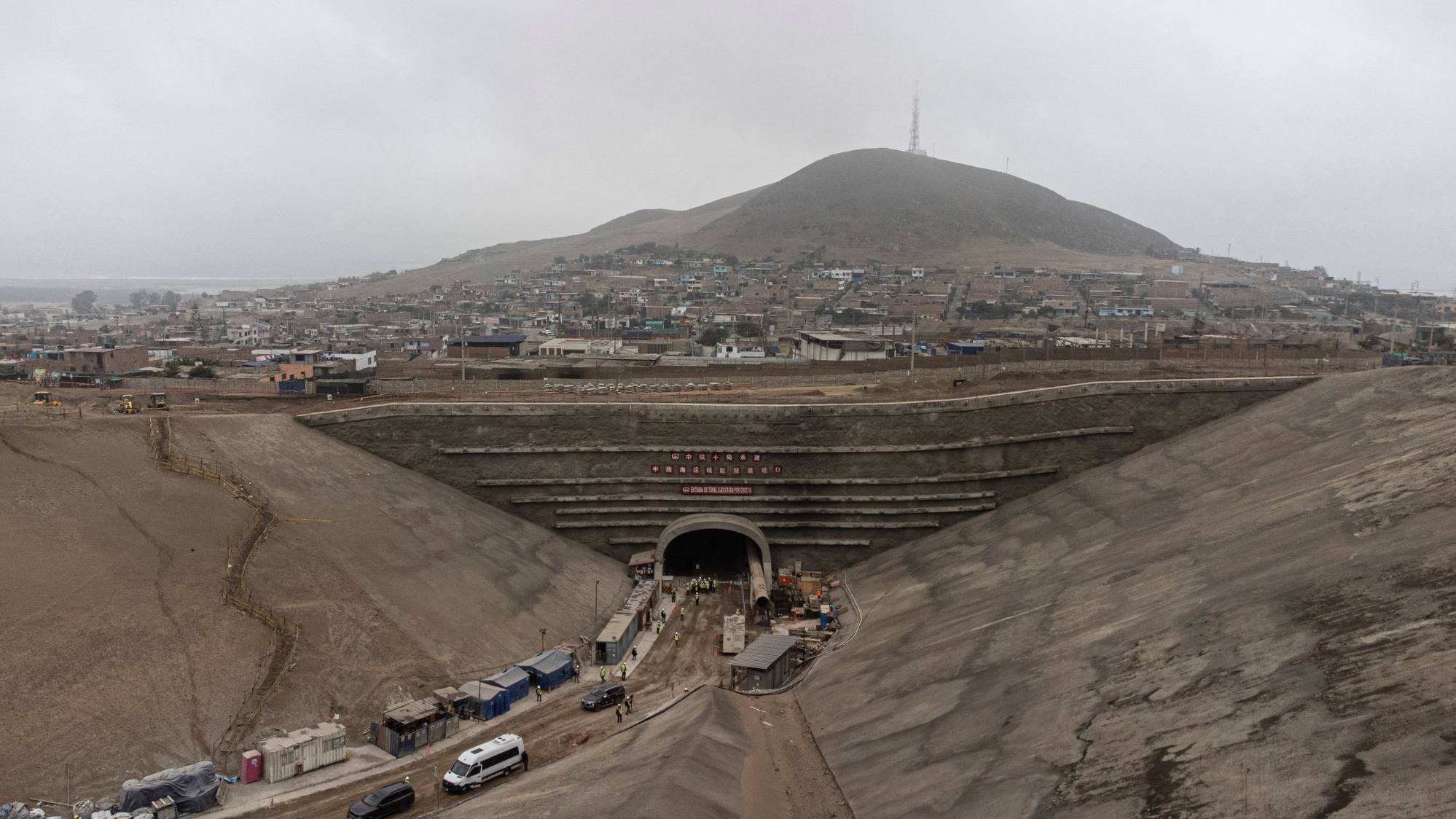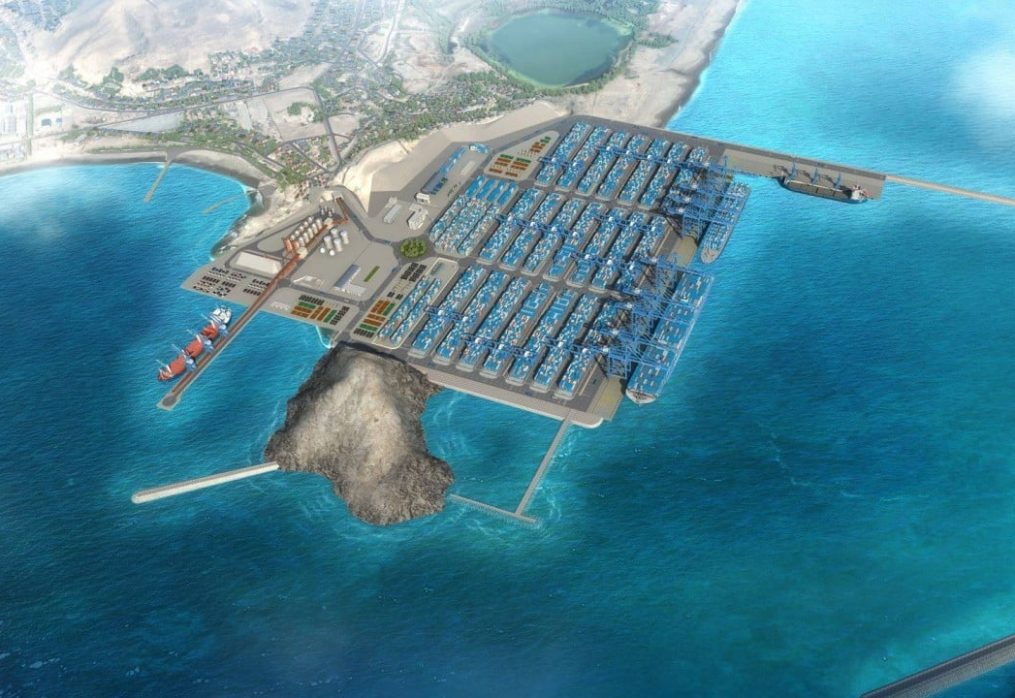Why is the US uneasy about China’s troubled US$3.6 billion port project in Peru?
“In terms of our national security concerns, there are all kinds of things that we can come up with and think through,” Richardson said last week, while urging Latin American countries to embrace safer business “alternatives” for such projects.
Lima is locked in a legal battle over a contract giving a subsidiary of Beijing-backed Cosco Shipping exclusive operating rights – months before Chinese President Xi Jinping is expected to attend the port’s inauguration and the Apec summit in Peru.
The deep-sea port of Chancay, located 72km (44 miles) from Lima, is being financed through China’s Belt and Road Initiative at a cost of US$3.6 billion.
‘The Shanghai of South America’
Commissioned in 2019, the megaport is envisioned as the first of its kind in Latin America: a large-scale Pacific-coast logistics centre serving Asia that saves valuable shipping time by reducing the need to transit either the Panama Canal or Cape Horn.
It would serve not only Peru, but also become the primary connecting point for goods from Ecuador, Chile, Colombia and Brazil bound for China. Combined, the five countries last year exported about US$135 billion to the Asian economic giant.
The port would become a hub for shipping out critical commodities like lithium – an essential element for EV batteries – as well as soybeans, corn, oil, iron and concrete. And it would offer a gateway to import Chinese manufactured goods to South America.
Liang Yu, the Chinese ambassador in Lima, has said in several interviews with local media that the city of Chancay has the potential to become the “Shanghai of South America”. The predictions are warranted, some analysts say.
Rubén Tang, of the Pontifical Catholic University of Peru and a former Apec legal adviser at the Peruvian trade and tourism ministry, said the country hoped to become “a trade superpower”.
The project would boost exports, open up new economic opportunities and help meet growing port demand by reducing logistics costs in the Peruvian market and globally, Tang added, citing its “strategic location” and the availability of sufficient land.
However, controversy has stalled the massive infrastructure project that Beijing views as pivotal to spurring its trade with South America.
The impasse highlights a tumultuous political environment in Lima, which has cycled through six administrations in the past eight years, amid Chinese efforts to shore up supplies of rare earths and agricultural commodities as Washington looks on.
Beijing agreed to finance the port’s construction on the understanding that Cosco Shipping Ports, a Hong Kong-listed subsidiary of the Chinese state-owned conglomerate of the same name, would be granted exclusive operating rights.
Then, in March, after years of design work and the demolition of older facilities on the site, Peru’s supervisory agency for investment in public-use transport infrastructure, known as Ositran, reported irregularities in the contract.
Most notably, the public body said the Peruvian signatory to the contract, the National Port Authority (NPA), lacked legal authority to grant exclusive operating rights.
Ositran then turned the case over to an independent body that evaluates Peruvian legal competition matters. As a result of Ositran’s action, NPA announced its intention to cancel Cosco’s exclusivity rights.

Thereafter, Cosco sent a letter to the Peruvian economic ministry, stating a deadline of six months to resolve the matter. The company made clear it would take the case to an international court of arbitration if no agreement materialised.
“The current notification … arises due to the manifestly unfair and inequitable treatment, among other violations of the agreement, that the state has been committing against our investment,” Cosco’s letter said.
It pointed a finger at “various executive bodies such as the ministry of transport, Ositran and the new composition” of the National Port Authority.
“Depriving Cosco of the exclusive operation of the port is equivalent to expropriation,” the company added. “Ositran cannot treat the port of Chancay as a public port.”
A ‘lack of coordination and efficiency’
In an interview with a local radio station in April, Peru’s economic minister, Jose Arista, confirmed he had received Cosco’s letter. Arista said he was “certain” Peru and Cosco would “reach an agreement before” needing to resort to an arbitration court.
Last month, Lima introduced a bill to amend the country’s national port system law. The proposed amendments, approved by the Peruvian Congress in April by a vote of 72-32, have created a possibility of Cosco reapplying for exclusivity rights.
Nevertheless, it remains uncertain how Peru’s judiciary might decide. The matter is currently being considered by a special court for administrative litigation in Lima, and no deadline has yet been given for a decision.
Neither Cosco in Beijing nor the Chinese embassy in Lima responded to the Post’s requests for comment on the project.
Tang said calls to cancel the exclusivity agreement had “caused many reversals and negatively affected the security of foreign investment in the country … and also shows the lack of coordination and inefficiency” among the state bodies handling the matter.
Nevertheless, he believed the measures taken by Peru’s Congress and the central government to amend the legislation regulating port activity would result in the Chinese company retaining its operating rights.
“With this legislative solution, [Congress] has ensured that the port of Chancay can open smoothly in November during the Apec summit,” Tang added.
‘It’s a PRC port. It’s a megaport’
Even if the Peruvian government were to resolve all the legal issues before the port’s planned inauguration, it would still have to address another obstacle: Washington’s repeated complaints.
According to one American official who spoke to the Financial Times in March, the Peruvian government is not focusing enough on analysing the benefits and risks associated with the project.
That same month, Richardson of the US Southern Command testified before the House Armed Services committee in Washington, describing the port as posing a significant risk to Washington’s interests in the region.

She voiced unease over a Chinese-operated port sitting on America’s “20-yard line”, following a Council on Foreign Relations report published weeks before identifying it as a China-backed maritime project that could be converted for military purposes.
Indeed, opponents of the project have seized on the fact the agreement signed between the Peruvian government and Cosco does not explicitly rule out such a conversion.
Speaking at a conference in Miami last week, Richardson revisited the ongoing debate surrounding the port.
In particular, she expressed concern about the potential military use of Chinese-funded infrastructure in South America, highlighting the Chinese government’s direct role in managing firms responsible for projects such as the Chancay port.
During a trip to Peru in September, she spent “a lot of time educating and informing” partners about the risks of involving “a communist government and its state-owned enterprises” as the backbone of their critical structure, Richardson recalled.
In noting South America’s wealth of resources, the commander said a Chinese-operated port would “further make it easier for the Chinese to extract [it] all” and “that should be concerning”.
“The ports and the status of cargo – 100 per cent of the cargo in and 100 per cent out – who’s doing your scanners?” Richardson continued. “Who’s gonna have all that information? Who’s going to have all that data? Is it going to be a PRC solution?”
“It’s a PRC port. It’s a megaport.”

Richardson acknowledged an absence of American solutions to the challenges she cited, yet argued viable alternatives existed when partnering with US-aligned democracies.
Specifically, she believed competing with Chinese influence in the region did not mean outspending but ensuring there were “like-minded democracy alternatives for countries” to be able to choose from.
“I’ve been trying to get the word out to our US businesses or US companies, partners, going out and seeking forums … to say, ‘We’ve got to be there competing, gotta have our jersey on, we gotta be on the field.’ Economic security is national security.”
Daniel Erikson, senior director for Western hemisphere affairs at the US National Security Council, also touted America’s democratic system as a “core advantage” for engaging with Latin America.
But he conceded that bureaucratic hurdles could at times limit White House actions as Peru and other countries in the region sought finance partners for their projects.
“We have a Congress, and Congress has passed laws that can, in some cases, constrain the types of assistance that we provide,” Erikson said. “That goes beyond any specific project, but it’s something that I think we’re certainly looking at more deeply.”
